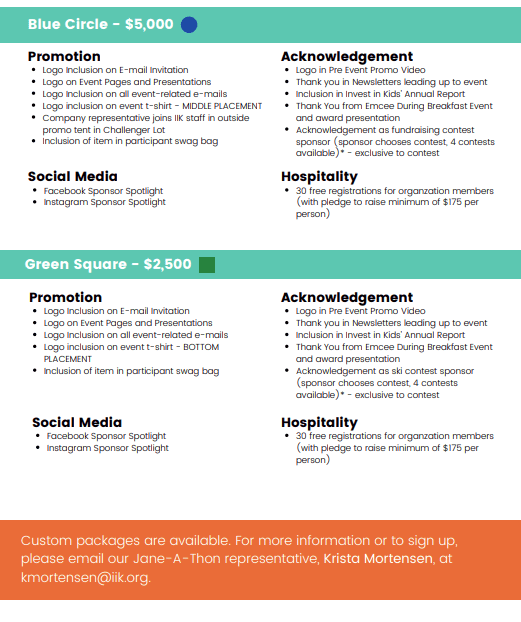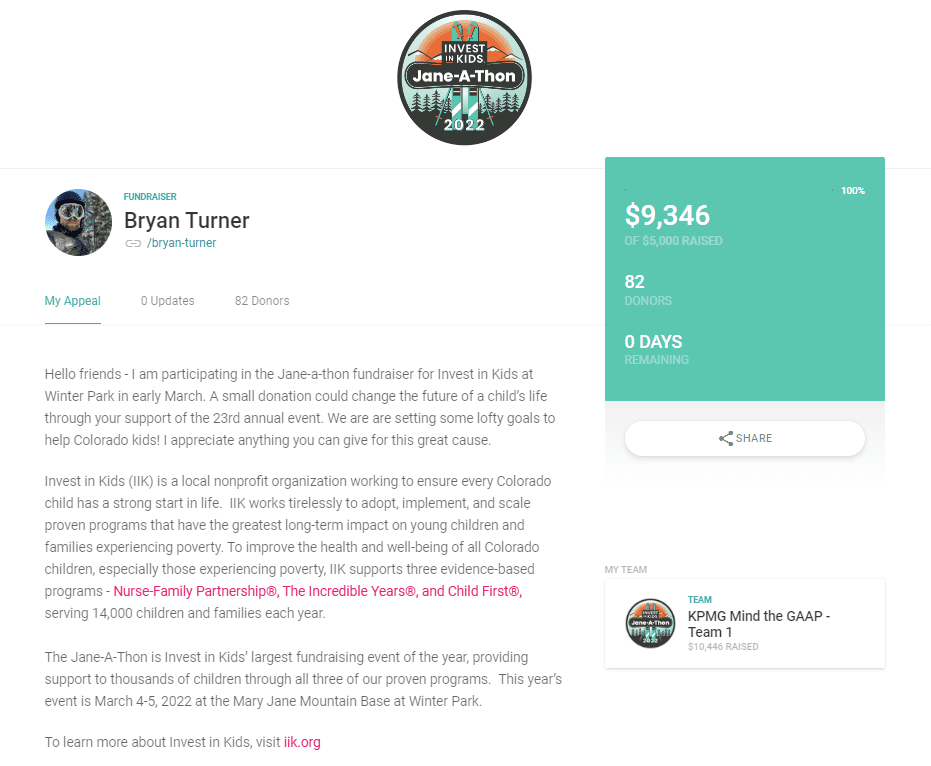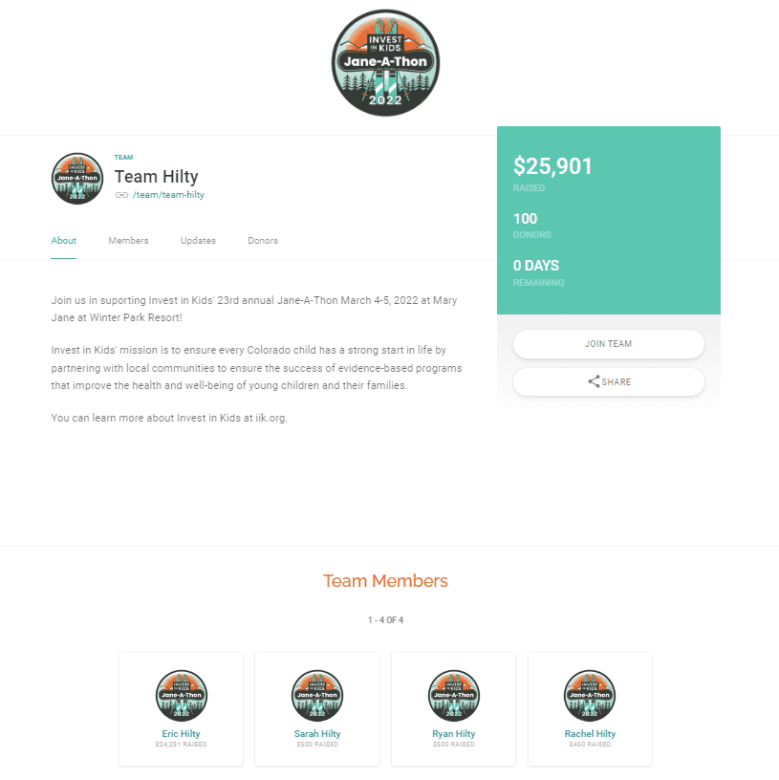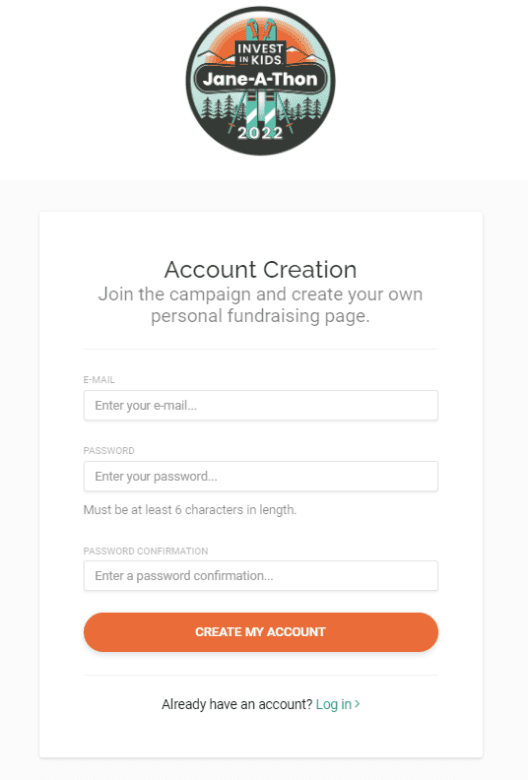Peer-to-peer fundraising is on the rise and it’s no wonder since they typically raise twice as much compared to other types of digital fundraising campaigns.
And who better to get peer-to-peer fundraising tips from than a nonprofit professional?
To get the scoop on running a successful peer-to-peer fundraiser, we sat down with Krista Mortensen, a seasoned fundraiser and the development manager at Invest in Kids to discuss fundraising tips that helped her raise a ton of money during their 2022 Jane-A-Thon event. In this article, we’ve boiled down the top peer-to-peer fundraising tips and strategies from our conversation that you can use in your next peer-to-peer fundraiser.
Who Is Invest In Kids?
Invest in Kids is a Denver-based nonprofit dedicated to improving the health and wellbeing of young children and families across the state. They offer three sub-programs – prenatal care, social-emotional learning, and intensive in-home family therapy – all with the goal of ensuring that Colorado’s youngest citizens have a strong start in life.
Peer-to-Peer Fundraising Campaign
For the past 23 years, Invest in Kids has hosted the Jane-A-Thon, a fun-filled ski and snowboarding event at Colorado’s Winter Park Resort. Whether participants are joining with a corporate sponsor, or signing up with family and friends, individuals of all ages and skill levels can make an impact by raising money for kids in need.
As part of their registration process for their most recent Jane-A-Thon, Invest in Kids charged each participant a $35 fee. The purpose of this was to ensure that participants would follow through with their fundraising commitment. However, this fee was waived for corporate participants if their company was sponsoring.
While the minimum fundraising goal for each participant was set at $175, participants were encouraged to raise beyond that. To encourage fundraising, Invest In Kids offered different levels of incentives and prizes. If participants hit the minimum, they received a benchmark prize but if they raised more, they could win bigger prizes. They also let donors know why they were raising money and translating the impact of gifts in terms of programming:

Corporate Sponsors for Peer-to-Peer Fundraising Events
In terms of peer-to-peer fundraisers, corporate sponsorships can be an invaluable but often untapped source of revenue. In a nutshell, corporate sponsorships are a mutually beneficial agreement between a company and a nonprofit. Generally, a corporate sponsor supports a nonprofit and in return, the nonprofit will promote the company. Corporate sponsorships can take many forms but the most common is financial or in-kind. For Invest In Kids, corporate sponsors provided both financial support and product donations to be used as prizes.
Getting Corporate Sponsors
When it comes to sourcing corporate sponsors, often the first thing that comes to mind is the dreaded cold call. But it doesn’t have to be that way. If you have a board of directors or an event sub-committee, remember that they’re here to support your cause! Capitalize on the natural network of connections that exists there for warm leads so you don’t have to start from scratch.
The hard part is the initial ask but once sponsors have developed a relationship with your org, it’s a lot easier to ask if they’d be interested in sponsoring your event again.
As part of your standard slate, offer potential sponsors four to five sponsorship levels that align with your event’s theme. Be sure to include what promotions and acknowledgments come with each level.


Pro Tip: Be flexible with your sponsorship package. Always make the ask but offer to customize it based on the company’s budget and needs. Sponsorship tiers may not be a one-size-fits-all so be willing to have a conversation with your potential sponsor to see how you can make it work for them!
Corporate Matching
Another way a company can support your peer-to-peer is through corporate matching. Corporate matching is a type of incentive that motivates donors to give in the moment, rallying donors quicker and more efficiently. With corporate matches, the donor usually has to submit some sort of proof (screenshot, receipt, etc.) to their company to claim the match. For their event, Invest in Kids regularly encouraged participants to submit their donations for corporate matching. It allowed donors to double their gift (and put them closer to winning bigger prizes). Once verified, the match was immediately reflected in their donation total.
Corporate Prize Donations
Procuring prizes for your peer-to-peer campaign doesn’t have to break your budget. If a company isn’t able to help financially, see if they’d be willing to support via an in-kind (noncash donations of goods, services, or time) contribution.
Different companies may have their own guidelines on how to request an in-kind donation. Sometimes, a company may have an in-kind request form that you can submit but it never hurts to personally reach out to local businesses. For the Jane-A-Thon, Invest In Kids was able to secure larger prizes by partnering with a sports retailer who offered them items that were on brand with their event.
Corporate Sponsors For Peer-to-Peers Are A Game Changer
Corporate sponsorships can help build momentum for fundraising even before people start building out their campaign pages. It can help you get ahead of the game and have measurable progress so that when your supporters do start registering, it won’t feel like starting from zero.
Peer-to-Peer Fundraising Structure
The anatomy of a peer-to-peer fundraiser consists of a landing page, team pages, and personal pages. The landing page is where teams and individuals can register to participate in your campaign. At minimum, a campaign should include the organization’s logo, a description of the event, and instructions on how to register. To make things easy on your fundraisers, we recommend including a fundraising toolkit with social media graphics, logos, pictures, and pre-templated text.

Since a peer-to-peer relies on your supporters to fundraise on your behalf, they register to create “mini-campaigns”. Depending on whether they’re fundraising with a group or individually, they will either create a team or personal page. No matter the page type, participants can personalize their own campaign pages to start collecting donations. If fundraisers are participating as a team, they will still create their own personal pages but the funds raised are funneled on the team page.

Donations collected across all teams and individual pages then feed into your overall campaign goal.
CauseVox makes creating fundraising pages a breeze. Participants can join a campaign by creating an account.

From there, registration is a simple five step process. Following the setup wizard, participants complete their profile, pay the registration fee (if there is one), set up their fundraising page, and write their appeal. While our fundraising pages come pre-populated with text, participants have a lot of flexibility within their own page.

If they wanted to, participants could edit the default text or add their own pictures and stories. The last step is simply to share their newly created campaign page with their friends and family.
Top Peer-to-Peer Fundraising Tips
Regardless of the type of peer-to-peer you want to run, these tips from Krista at Invest in Kids are fairly universal.
#1 Fundraising Mistake To Avoid
The top fundraising mistake you can make is not asking. It can be tough to approach a new sponsor or donor but if you don’t ask the answer will always be “no”.
Keep It Simple
At the end of the day, Krista’s top peer-to-peer fundraising tip is that you should keep things simple. You don’t need to mimic complex campaigns (especially if you’re just starting out) or reinvent the wheel. Find what works for your org and work to refine and sharpen that edge. The bells and whistles aren’t necessary if it’s not something your audience is asking for. Remember, finding what works is an iterative process. Start off with the basics and add on over time.
Ready, Set, Go!
We’ll help you get your next peer-to-peer up and running in no time so you can start raising more money, more efficiently than before.
Get started for free using peer-to-peer fundraising with CauseVox!
Editor's Picks
Ultimate Guide To Peer-to-Peer Fundraising
Customer Story: Spur Local Raises Over $1M With Their Give Local Campaign
Fundraising Strategies for Nonprofits: Craft the Best Approach for Your Organization
Create a Killer Fundraising Plan - Best Practices, Strategies, & Downloadable Template



